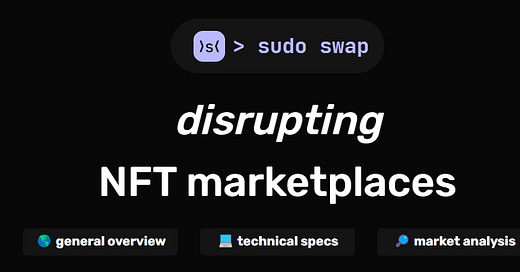When you think of an NFT marketplace, what do you think of? For most, its the standard P2P exchange that the most popular marketplaces have today. OpenSea, the largest NFT marketplace by volume, uses this traditional method to allow their users to buy and sell NFTs. However, Sudoswap has recently launched their newest marketplace, sudoAMM, disrupting the current landscape of NFT marketplaces.
General Overview of Sudoswap
Sudoswap is an NFT marketplace that is “highly flexible, gas-efficient, and fully on-chain.” What makes it different from other NFT marketplaces is the fact that it is an AMM protocol rather than a P2P exchange. Sudoswap is also fully permissionless with anyone being able to create their own pools or interact with the protocol.
Both buyers can sellers can buy/sell NFTs instantly using Sudoswap’s bonding curves. There is also the additional option to make an offer for a counterparty to accept. Currently, there are only two types of bonding curves, linear and exponential. Sudoswap as a protocol takes 0.5% of volume as fees.
Technical Specifications of Sudoswap
Pairs
Three types of pairs can be created from the PAIR_FACTORY contract. A “Token” pair holds tokens (ETH or ERC20) and can pay for an NFT in a collection at a given price. An “NFT” pair does the inverse, holding NFTs and can sell it at a given price. A “Trade” pair holds both and can both buy and sell at specified prices. Trade pairs allow LPers to earn fees based on the delta (explained later). Any NFT or ERC20 can be set by the caller of the contract as well as specifying the type of bonding curve used.
Bonding Curves
To determine the price of the NFTs, two types of bonding curves can be used. They both rely on something called a “delta”, which is the factor that the price changes by each time.
Linear curves add or subtract the price of an NFT by the given delta linearly. For example, if the starting price of the NFT is 1 ETH and the delta is set to 0.1, each time an NFT is bought or sold in the pool the price of the NFT increases or decreases by 0.1. Here are some graphs to demonstrate:
Exponential curves multiply or divide the price of an NFT by the given delta. Using the same parameters as the previous example, each time an NFT is bought or sold the price of the NFT is multiplied or divided by 10%. Here are some more graphs to demonstrate:
Swaps
In order to make swaps, the PAIR_ROUTER contract is called. When swapping NFTs and tokens, there are two types of swaps that can be performed, a normal swap and a robust swap.
Both swaps consists of a maximum input (what you’re sending), minimum output (what you’re receiving), the swap route (which pairs you’re using to swap), and a deadline. The difference between a normal and robust swap is how the slippage is checked. A normal swap checks if the slippage is exceeded at the end in aggregate while a robust swap checks the slippage after each swap and skip the route if the slippage is exceeded. Robust swaps avoid the transaction from totally reverting and can partially fill the order while refunding the rest if the slippage is too high.
Additionally, NFT to NFT swaps are also possible by swapping the NFT for tokens then the tokens for the an NFT.
How Sudoswap Compares to Other NFT Marketplaces
Statistical comparisons were made mainly using these two Dune dashboards, NFT Market Overview by Hildobby and SudoAMM by 0xRob.
Decentralization
Sudoswap as an NFT marketplace protocol is completely decentralized, allowing anyone to use the protocol permissionlessly. The team has no control over the creation of pairs or orders filled by the smart contracts. This is much more decentralized when compared to other marketplaces such as OpenSea or LooksRare that have centralized authority over their platforms with the ability to freeze or delist specific NFTs or blacklist users.
Marketplace Mechanisms
As mentioned in the introduction, the majority of other NFT platforms such as OpenSea, LooksRare, and Rarible use a traditional P2P marketplace mechanism where users can list or make offers on certain NFTs. NFTX is a more unique NFT marketplace allowing users to lock and wrap their NFTs into ERC20s to make collections more liquid.
Volume, Fees, & Users
Sudoswap is currently averaging ~600 ETH in daily volume, which equates to roughly $900,000 at a price of $1500/ETH. This would make it the second largest NFT marketplace by volume, behind OpenSea and comparable to LooksRare. They make up ~5% of total NFT marketplace volume.
Sudoswap takes a 0.5% of volume in fees, compared to 2.5% by OpenSea and 2% by LooksRare (100% of which goes to LOOKS stakers). This would put Sudoswap as the third largest NFT platform by fees generated (~3 ETH or $4500 at $1500/ETH in daily fees). However, if you consider that not all or even most of the fees that LooksRare generates goes directly to the protocol, Sudoswap may be generating more than them as a platform.
Sudoswap is averaging ~1300 daily users with ~800 of them being new users. This makes them the second largest NFT marketplace by daily active users, about 3x more than their next closest competitor, LooksRare. However, this only makes them ~3% of the total NFT marketplace daily active users.
Closing Thoughts
Sudoswap has rapidly grown in the past month to become the second largest NFT marketplace. What really sets them apart from other marketplaces is the way it was built. Their disruption in both the decentralized nature and innovative marketplace allows for novel projects to be developed using their platform, and brings more control to the users.
If you want to learn more about Sudoswap read their docs.
Thank you for reading.
Special thanks to 0xmons for their help in this article.









Great Article , Do check out Golom as well
https://twitter.com/golom_io
https://docs.golom.io/